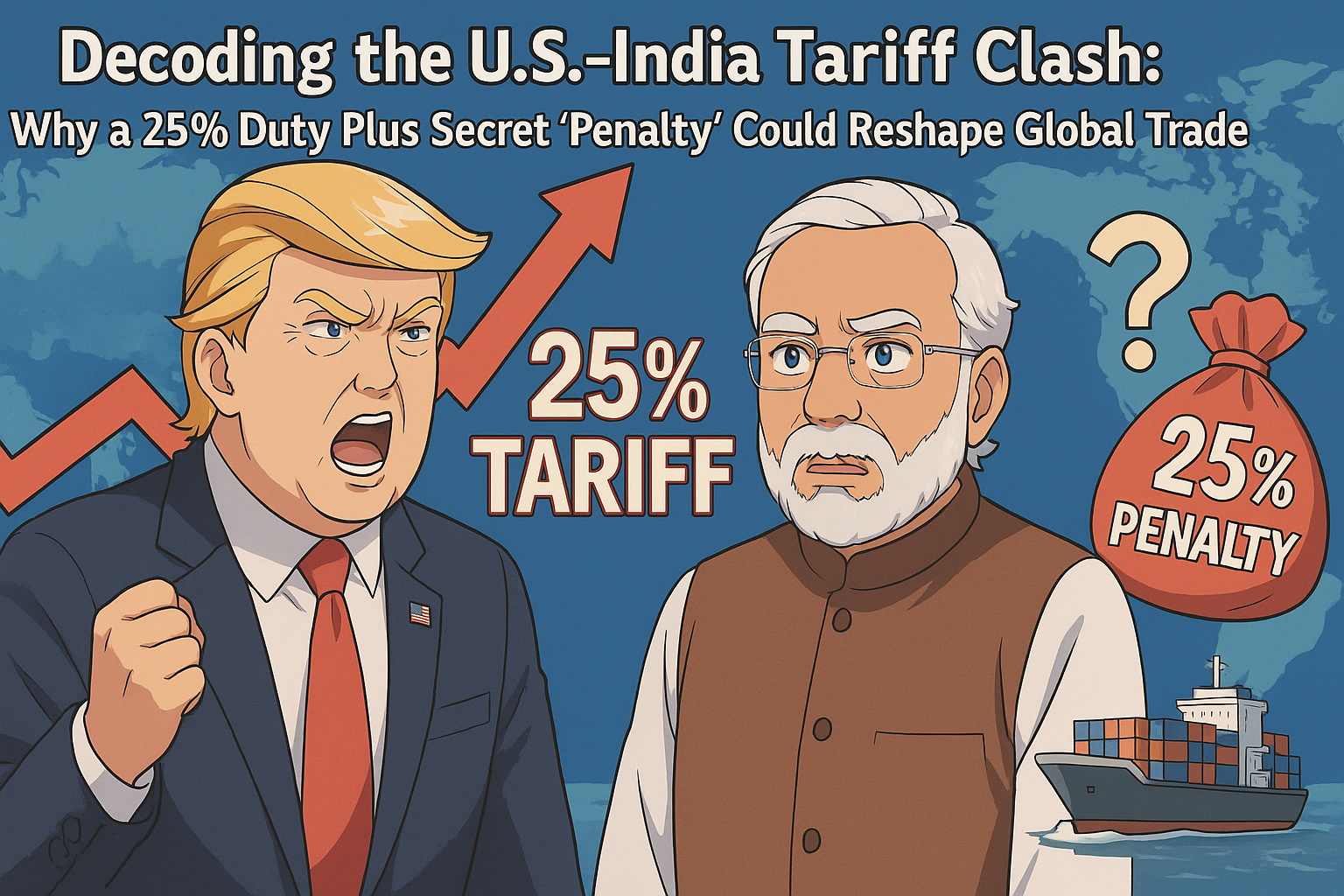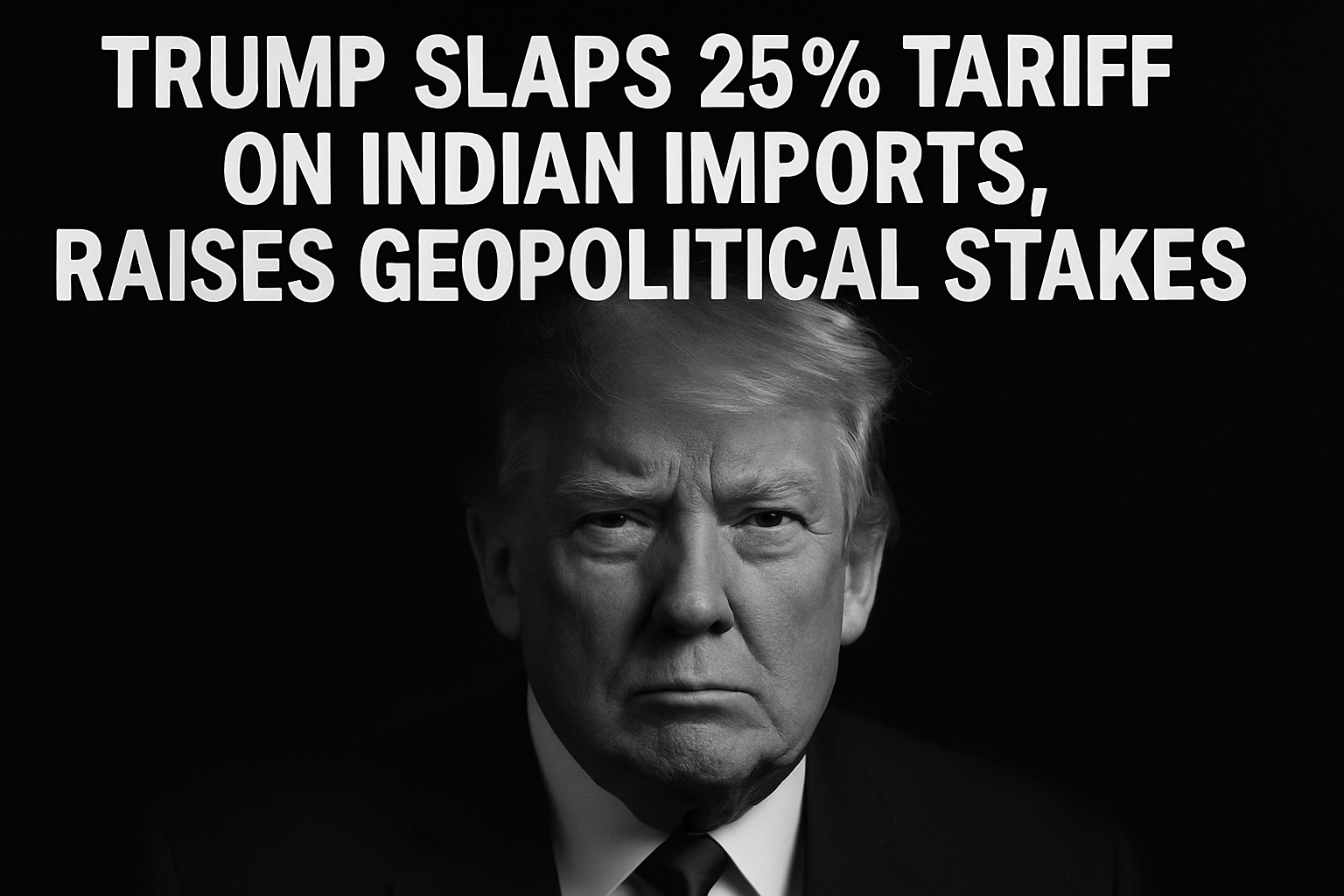In a bold trade move, the U.S. has imposed a 25% tariff on Indian exports—plus an undisclosed penalty tied to India’s Russia ties. RagaDecode investigates the real cost of this policy, who gains, who loses, and what India’s strategy should be next.
WHO: The Players Behind the Tariff Tensions
At the center of this diplomatic-economic standoff are the governments of the United States and India, led by President Donald Trump and Prime Minister Narendra Modi, respectively. The U.S. Trade Representative (USTR) announced a sweeping 25% tariff on a range of Indian goods, citing "national security concerns" and "strategic recalibration" in light of India's continued trade with Russia.
Though framed as a security move, the real players impacted include:
- Indian Exporters: Shrimp farmers in Andhra Pradesh, textile mills in Tamil Nadu, leather tanneries in Kanpur, and auto part makers in Pune.
- U.S. Importers: Businesses dependent on affordable Indian inputs.
- American Consumers: End-users now facing price hikes on goods that previously relied on India’s cost-efficient supply chain.
- Trade Analysts & Geopolitical Observers: Parsing whether the move is strategic pressure or trade bullying.
WHAT: Understanding the Tariff and Its Unnamed 'Penalty'
As of August 1, 2025, Indian exports to the U.S. are now subjected to a flat 25% tariff. But there’s a twist: a second layer of punitive penalty has been applied, the rate of which remains undisclosed.
Key sectors affected:
- Jewelry
- Textiles
- Leather goods
- Ceramic tiles
- Seafood (notably shrimp)
- Auto components
- Generic medicines
According to multiple U.S. media sources, the penalty is believed to be linked to India’s growing defense and energy imports from Russia—a form of backdoor sanctions without naming them.
Example: Shrimp exporters report that U.S. buyers are slashing prices by 10% post-announcement to offset their added cost burden.
The lack of transparency around the additional penalty is causing uncertainty across export-dependent industries.
WHEN: Timeline of Escalation
- Early 2025: U.S. intelligence reports increased India-Russia defense cooperation.
- March 2025: India signs oil and military equipment deals with Russia.
- June 2025: Quiet discussions begin in Washington on penalizing trade partners bypassing Russia sanctions.
- July 30, 2025: President Trump publicly announces the 25% tariff plus "an additional penalty."
- August 1, 2025: Tariffs take effect. Indian stock markets react with a 2% dip.
- August 2025: India and the U.S. prepare for the 7th round of bilateral free trade agreement (FTA) talks.
WHERE: Mapping the Impact
The effects are uneven but significant:
Most Affected States in India:
- Gujarat: Jewelry and ceramic industries.
- Tamil Nadu: Textiles and leather exports.
- Andhra Pradesh: Shrimp farming and seafood processing.
- Maharashtra & Karnataka: Auto components and generic drug manufacturers.
Least Affected Sectors:
- Cement, steel (already tariffed), and domestic utility sectors.
Global Comparisons:
- India isn’t alone. Turkey, Egypt, and Brazil face similar, less-publicized penalties due to energy trade with Russia.
WHY: Dissecting the U.S. Motive
The penalty is not just about trade economics but geopolitics.
- Countering Russia: India continues to import discounted Russian crude and weapons, despite Western pressure.
- U.S. Hegemony: The tariff acts as a warning to middle powers deviating from U.S. strategic interests.
- Election Optics: Trump seeks to project strength and nationalism ahead of the 2026 midterms.
- China Strategy: By tightening the screws on India, the U.S. may be indirectly coaxing alignment in its Indo-Pacific doctrine.
"India wants strategic autonomy, but that comes with a cost in a polarized world order." — U.S. Diplomat (anonymous)
HOW: India's Response and Strategic Playbook
India has opted for a restrained but multi-pronged response:
- Diplomatic Channels: Fast-tracking the 7th FTA negotiation round with a focus on digital goods, pharmaceuticals, and service access.
- Potential Retaliation: Consideration of mirror tariffs on luxury U.S. imports like Harley-Davidson bikes and premium spirits.
- Boosting Self-Reliance:
- Acceleration of "Make in India 2.0" initiative
- Incentives for domestic R&D and industrial manufacturing
- SME loan subsidies and tax breaks in affected sectors
- Diversifying Trade Partners: Increasing exports to ASEAN, Africa, and Latin America to offset U.S. market losses.
"We won’t be provoked into a tit-for-tat war, but we won’t be passive either." — Indian Commerce Minister
Market Reactions and Long-Term Forecast
- Stock Market: Sensex dropped 1.8% after Trump’s tariff tweet. Recovery seen as muted but stable.
- Currency: The rupee slid slightly against the dollar but stabilized within 48 hours.
- Investor Sentiment: Short-term dip in export-heavy sectors, but positive signals in domestic consumption and infrastructure.
- Economic Forecast: The impact on India’s GDP is marginal as U.S. trade constitutes just ~2% of the total economy.
Political and Public Sentiment
- India's Tone: Quiet strength. Avoiding escalation but asserting sovereignty.
- Public Opinion: Mixed. Nationalist factions call for retaliation; business groups urge calm and economic pragmatism.
- Modi-Trump Optics: Warmth in public, divergence in policy.
"Friendship is one thing; trade is another." — Delhi policy expert
Conclusion: Resilience Over Reaction
While the tariffs are a wake-up call, India is positioned to weather this storm. The key lies in:
- Recalibrating trade reliance
- Strategic diplomacy
- Investing in domestic industry
India is no stranger to protectionism. This time, the challenge is wrapped in geopolitical theater and digital megaphone diplomacy.
"The U.S. is acting like a lone landlord, raising rents arbitrarily. But tenants build their own homes when pushed." — Policy analyst
Stay tuned for follow-ups on India’s FTA negotiations and real-time tariff enforcement data. RagaDecode will continue to dissect the implications of this evolving trade showdown.



